-
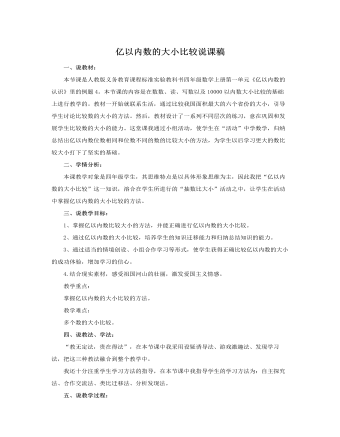
人教版新课标小学数学四年级上册亿以内数的大小比较说课稿
一、说教材:本节课是人教版义务教育课程标准实验教科书四年级数学上册第一单元《亿以内数的认识》里的例题4。本节课的内容是在数数、读、写数以及10000以内数大小比较的基础上进行教学的。教材一开始就联系生活,通过比较我国面积最大的六个省份的大小,引导学生讨论比较数的大小的方法。然后,教材设计了一系列不同层次的练习,意在巩固和发展学生比较数的大小的能力。这堂课我通过小组活动,使学生在“活动”中学数学,归纳总结出亿以内数位数相同和位数不同的数的比较大小的方法,为学生以后学习更大的数比较大小打下了坚实的基础。二、学情分析:本课教学对象是四年级学生,其思维特点是以具体形象思维为主,因此我把“亿以内数的大小比较”这一知识,溶合在学生所进行的“抽数比大小”活动之中,让学生在活动中掌握亿以内数的大小比较的方法。
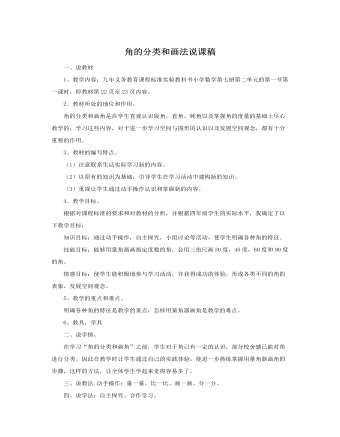
人教版新课标小学数学四年级上册角的分类和画法说课稿
(三)应用知识,解决问题。“学以致用”,新知识一旦形成,务必应用它来解决问题,使它进一步形成技能,技巧,心理学研究表明:学用结合是提高深化学生巩固知识的重要环节,所以设计以下练习:(略)(四)全课小结:这节课我们学习什么内容?角可以分为哪几类?怎样用量角器画指定度数的角呢?课外延伸:学生收集不同的角,下节课比一比谁找得最多。(五)学生互相评价,自己评价自己,(互评,自评)六、说板书设计板书内容是一节课的精髓,能体现教学内容和教学重点,反映教学思维的过程。七、说教学评价。本课时的教学,我大胆组织教材,层次分明,重点突出,分散难点,始终围绕着教学目标进行教学。导入新颖,创设情景,使学生进入有序思维,首尾呼应志趣相融,整个教学过程注重学生参与,充分体现以学生为主体的作用,本节课板书大方,一目了然,各个环节衔接合理。

人教版新课标小学数学四年级上册亿以内数的读写法说课稿
本单元教学内容是亿以内数的读法和写法.教材是在学生学习了万以内数的读法和写法,已经掌握了“个”、“十”、“百”、“千”这几个计数单位,并且会正确地读写万以内数的基础上,把计数单位扩展到“亿”,再分别学习万级数的读法和含有两级的数的读法,万级数的写法和含有两级数的写法,最后学习比较数的大小,把整万的数改写成用万作单位的数,以及用“四舍五入”法把一个亿以内的数改写成用万作单位的近似数.通过本单元的教学,使学生能够按照四位一级的计数特点正确读、写亿以内的数.帮助学生建立较完整的计数知识体系.为进一步学习亿以内加法和减法,乘数和除数是三位数的乘法和除法打下基础.本单元教学重点是万级数的读法和写法,培养学生运用迁移、类推的方法获取新知,并进一步培养学生的分析、综合能力.

人教版新课标小学数学四年级上册数的产生说课稿
一、创造性地使用教材。上课前,我就布置了学生收集相关的“数”的产生的资料,初步感知“数”的产生历史及变化过程;上课后,我将数位的产生融入“数的产生”这样大的背景中,使学生感受数学王国的博大与神奇。二、把学习的主动权利教给学生,放手让学生去探索、去发现,给予学生思维的空间。如:我在教学“探索十进制计数法”一节时,给学生提供一张不完整的数位顺序表,让学生填写完整并说出依据。学生通过自己动脑思考、动手填写,就会发现“相邻两计数单位间的进率都是十”,既而明白:相邻两单位进率是十的计数法就是十进制计数法,课堂效果十分明显。三、困惑与反思:本节课对十进制计数法教学法的设计虽然取得了较明显的效果,但对于“数位”、“位数”、“计数单位”这些概念该不该讲?怎样讲才能让学生理解得更透彻,我感到困惑。
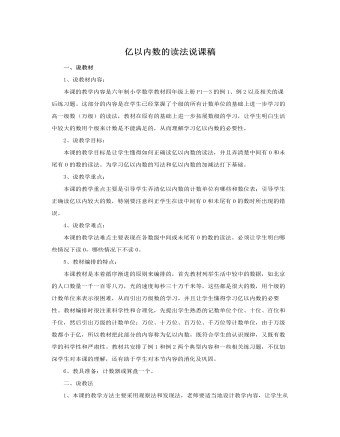
人教版新课标小学数学四年级上册亿以内数的读法说课稿
(三)通过观察,找出规律教师可以这样设计,用计数器演示,个级的各个数位,然后让学生观察找出万级的计数单位,学生很快从中找出万级的计数单位,知道万位、十万位、百万位和千万位,这时为了加深对本节课内容的理解,可以通学习例1和例2的内容。学习例1,教师出示例题内容:470000、3080000、40500000。为了让学生直观地看出以上数所占的数位,可以用计数来帮助,把相应数位相互对齐。学生经过观察可能发现其中的道理,以470000为例,4对应十万位、7对应万位、后面全部是0,学生很快读出这个数,读作47万。用相似的方法来学习其它内容,学生会总结出这些数的读法。接着学习例2,情况和教学内容虽然稍有不同,但经过教师适当地引导,学生肯定能够掌握,由于方法相似,在这里就不展开讨论。通过以上两个例题的学习,学生应该明白了亿以内数的读法了,不过由于0在各种情况下出现,其也有不同的读法,教师要引导学生弄清在何种情况下如何读中间有0或未尾有0的数,这是本课学习的重点与难点,必须让学生掌握。
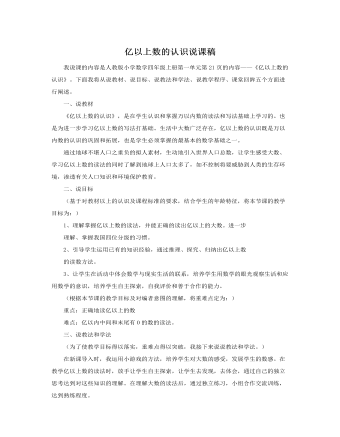
人教版新课标小学数学四年级上册亿以上数的认识说课稿
我说课的内容是人教版小学数学四年级上册第一单元第21页的内容——《亿以上数的认识》。下面我将从说教材、说目标、说教法和学法、说教学程序、课堂回眸五个方面进行阐述。一、说教材《亿以上数的认识》,是在学生认识和掌握万以内数的读法和写法基础上学习的。也是为进一步学习亿以上数的写法打基础。生活中大数广泛存在,亿以上数的认识既是万以内数的认识的巩固和拓展,也是学生必须掌握的最基本的数学基础之一。通过地球不堪人口之重负的拟人素材,生动地引入世界人口总数,让学生感受大数、学习亿以上数的读法的同时了解到地球上人口太多了,如不控制将要威胁到人类的生存环境,渗透有关人口知识和环境保护教育。二、说目标(基于对教材以上的认识及课程标准的要求,结合学生的年龄特征,将本节课的教学目标为:)
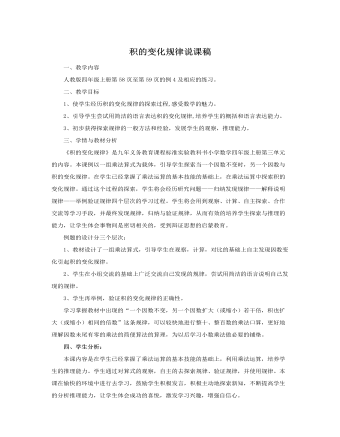
人教版新课标小学数学四年级上册积的变化规律说课稿
三、学情与教材分析《积的变化规律》是九年义务教育课程标准实验教科书小学数学四年级上册第三单元的内容。本课例以一组乘法算式为载体,引导学生探索当一个因数不变时,另一个因数与积的变化规律。在学生已经掌握了乘法运算的基本技能的基础上,在乘法运算中探索积的变化规律。通过这个过程的探索,学生将会经历研究问题——归纳发现规律——解释说明规律——举例验证规律四个层次的学习过程。学生将会用到观察、计算、自主探索、合作交流等学习手段,并最终发现规律,归纳与验证规律,从而有效的培养学生探索与推理的能力,让学生体会事物间是密切相关的,受到辩证思想的启蒙教育。例题的设计分三个层次:1、教材设计了一组乘法算式,引导学生在观察,计算,对比的基础上自主发现因数变化引起积的变化规律。
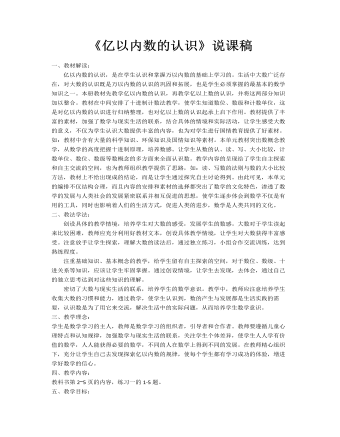
小学数学人教版四年级上册《亿以内数的认识》说课稿
三、教学理念:学生是数学学习的主人,教师是数学学习的组织者,引导者和合作者。教师要遵循儿童心理特点和认知规律,加强数学与现实生活的联系,关注学生个体差异,使学生人人学有价值的数学,人人能获得必要的数学,不同的人在数学上得到不同的发展。在教师精心组织下,充分让学生自己去发现探索亿以内数的规律,使每个学生都有学习成功的体验,增进学好数学的信心。四、教学内容:教科书第2~5页的内容,练习一的1-5题。五、教学目标:1.使学生认识计数单位"万""十万""百万""千万"和"亿",知道亿是个大数;知道亿以内各计数单位的名称和相邻两个单位之间的十进关系。2.掌握数位顺序,理解并掌握我国四位一级的计数习惯,能够根据数级正确地读出亿以内的数。3.通过情境创设,小组合作学习等形式,使学生获得正确读数的成功体验;培养学生分析、综合的能力。4.培养学生对大数的感受,发展学生的数感。六、教学重点:亿以内数的认识,读法。七、教学难点:1. 数级、数位、计数单位的区别以及"位值"的理解。2.每级中间或末尾有0的读法。八、教具学具:教师准备PPT课件,数位表,师生都备计数器。
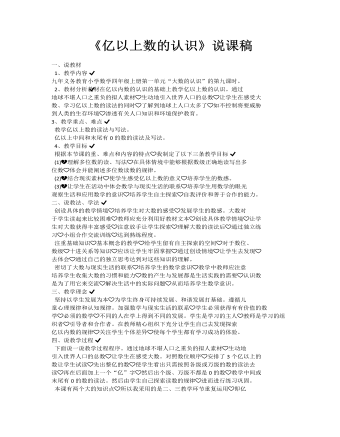
小学数学人教版四年级上册《亿以上数的认识》说课稿
一、说教材 1、教学内容 九年义务教育小学数学四年级上册第一单元“大数的认识”的第九课时。 2、教材分析教材在亿以内数的认识的基础上教学亿以上数的认识。通过地球不堪人口之重负的拟人素材生动地引入世界人口的总数让学生在感受大数、学习亿以上数的读法的同时了解到地球上人口太多了如不控制将要威胁到人类的生存环境渗透有关人口知识和环境保护教育。 3、教学重点、难点 教学亿以上数的读法与写法。 亿以上中间和末尾有0的数的读法及写法。 4、教学目标 根据本节课的重、难点和内容的特点我制定了以下三条教学目标 (1)理解多位数的读、写法在具体情境中能够根据数级正确地读写出多位数体会并能阐述多位数读数的规律。 (2)结合现实素材使学生感受亿以上数的意义培养学生的数感。 (3)让学生在活动中体会数学与现实生活的联系培养学生用数学的眼光观察生活和应用数学的意识培养学生自主探索自我评价和善于合作的能力。
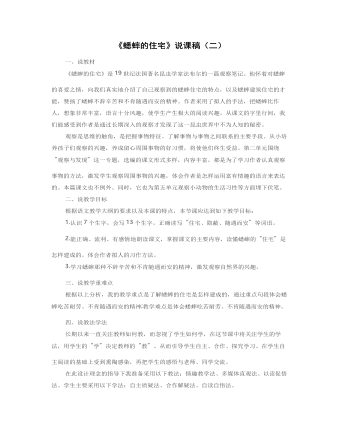
(新)部编人教版四年级上册《 蟋蟀的住宅》说课稿(二)
(一)联系生活、激趣导入新课标指出,应拓宽语文学习和运用的领域,注重跨学科的学习和现代化科技手段的运用,使学生在不同内容和方法的相互交叉、渗透和整合中开阔视野,提高学习效率,初步获得现代社会所需要的语文实践能力。上课前,学生在以前已经学过口语交际介绍自己的家,学生会非常自豪,能踊跃地说。再加上课前对蟋蟀的已知了解,学生已经知道蟋蟀的歌声动听,对蟋蟀的可爱、有趣早已铭记在心。这样二者结合起来,能很好地调动学生学习的兴趣,实现旧知迁移,为学生转换角色,改变学习方式作准备,也为学生发展口语作准备。这样让学生把自己的家和早已熟悉的蟋蟀的住宅联系起来,自然而然地导入课题。
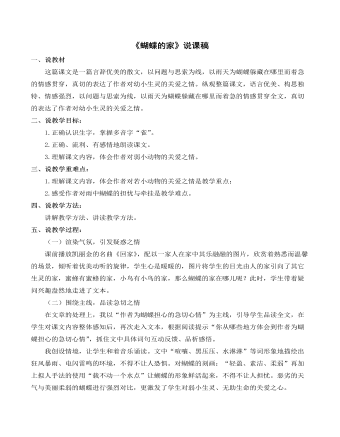
(新)部编人教版四年级上册《蝴蝶的家》说课稿
三、说教学重难点:1.理解课文内容,体会作者对若小动物的关爱之情是教学重点;2.感受作者对雨中蝴蝶的担忧与牵挂是教学难点。四、说教学方法: 讲解教学方法、讲读教学方法。五、说教学过程:(一)渲染气氛,引发疑惑之情课前播放凯丽金的名曲《回家》,配以一家人在家中其乐融融的图片,欣赏着熟悉而温馨的场景,倾听着优美动听的旋律,学生心是暖暖的,图片将学生的目光由人的家引向了其它生灵的家,蜜蜂有蜜蜂的家,小鸟有小鸟的家,那么蝴蝶的家在哪儿呢?此时,学生带着疑问兴趣盎然地走进了文本。
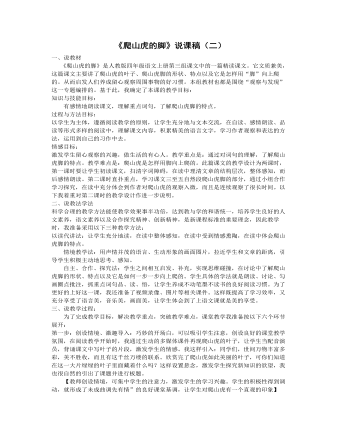
(新)部编人教版四年级上册《 爬山虎的脚》说课稿(二)
有感情地朗读课文,理解重点词句,了解爬山虎脚的特点。过程与方法目标:以学生为主体,遵循阅读教学的原则,让学生充分地与文本交流,在自读、感情朗读、品读等形式多样的阅读中,理解课文内容,积累精美的语言文字,学习作者观察和表达的方法,运用到自己的习作中去。情感目标:激发学生留心观察的兴趣,做生活的有心人。教学重点是:通过对词句的理解,了解爬山虎脚的特点。教学难点是:爬山虎是怎样用脚向上爬的。此篇课文的教学设计为两课时,第一课时要让学生初读课文,扫清字词障碍,在读中理清文章的结构层次,整体感知,而后感情朗读。第二课时直扑重点,学习课文三至五自然段爬山虎脚的部分,通过小组合作学习探究,在读中充分体会到作者对爬山虎的观察入微,而且是连续观察了很长时间。以下我着重对第二课时的教学设计作进一步说明。
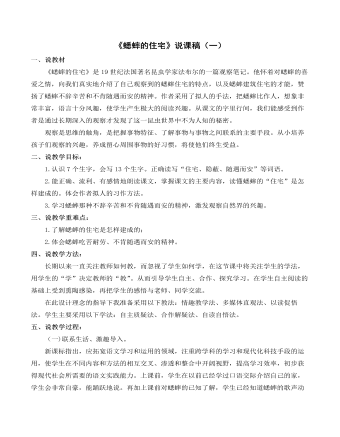
(新)部编人教版四年级上册《蟋蟀的住宅》说课稿(一)
二、说教学目标: 1.认识7个生字,会写13个生字。正确读写“住宅、隐蔽、随遇而安”等词语。2.能正确、流利、有感情地朗读课文,掌握课文的主要内容,读懂蟋蟀的“住宅”是怎样建成的。体会作者拟人的习作方法。 3.学习蟋蟀那种不辞辛苦和不肯随遇而安的精神,激发观察自然界的兴趣。三、说教学重难点:1.了解蟋蟀的住宅是怎样建成的;2.体会蟋蟀吃苦耐劳、不肯随遇而安的精神。四、说教学方法: 长期以来一直关注教师如何教,而忽视了学生如何学,在这节课中将关注学生的学法,用学生的“学”决定教师的“教”。从而引导学生自主、合作、探究学习。在学生自主阅读的基础上受到熏陶感染,再把学生的感悟与老师、同学交流。 在此设计理念的指导下我准备采用以下教法:情趣教学法、多媒体直观法、以读促悟法。学生主要采用以下学法:自主质疑法、合作解疑法、自读自悟法。
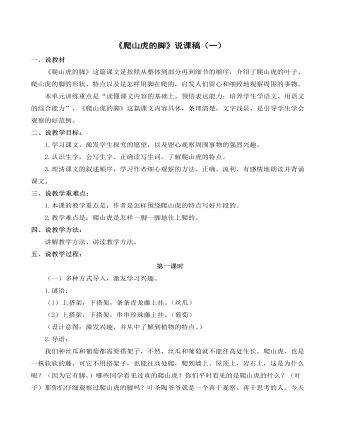
(新)部编人教版四年级上册《爬山虎的脚》说课稿(一)
一、说教材 《爬山虎的脚》这篇课文是按照从整体到部分再到细节的顺序,介绍了爬山虎的叶子、爬山虎的脚的形状、特点以及是怎样用脚在爬的,启发人们留心和细致地观察周围的事物。本单元训练重点是“读懂课文内容的基础上,领悟表达能力;培养学生学语文、用语文的综合能力”,《爬山虎的脚》这篇课文内容具体,条理清楚,文字浅显,是引导学生学会观察的好范例。二、说教学目标: 1.学习课文,激发学生探究的愿望,以及留心观察周围事物的强烈兴趣。 2.认识生字,会写生字。正确读写生词。了解爬山虎的特点。3.理清课文的叙述顺序,学习作者细心观察的方法。正确、流利、有感情地朗读并背诵课文。 三、说教学重难点:1.本课的教学重点是:作者是怎样围绕爬山虎的特点写好片段的。2.教学难点是:爬山虎是怎样一脚一脚地往上爬的。四、说教学方法: 讲解教学方法、讲读教学方法。
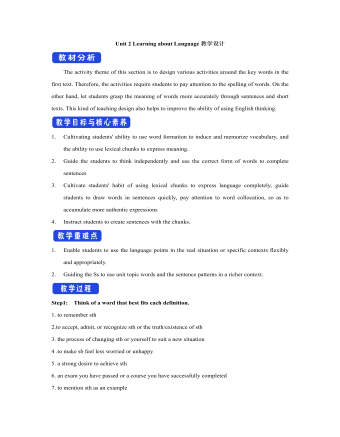
新人教版高中英语选修2Unit 2 Learning about Language教学设计
The activity theme of this section is to design various activities around the key words in the first text. Therefore, the activities require students to pay attention to the spelling of words. On the other hand, let students grasp the meaning of words more accurately through sentences and short texts. This kind of teaching design also helps to improve the ability of using English thinking.1. Cultivating students' ability to use word formation to induce and memorize vocabulary, and the ability to use lexical chunks to express meaning.2. Guide the students to think independently and use the correct form of words to complete sentences3. Cultivate students' habit of using lexical chunks to express language completely, guide students to draw words in sentences quickly, pay attention to word collocation, so as to accumulate more authentic expressions4. Instruct students to create sentences with the chunks.1. Enable students to use the language points in the real situation or specific contexts flexibly and appropriately.2. Guiding the Ss to use unit topic words and the sentence patterns in a richer context.Step1: Think of a word that best fits each definition.1. to remember sth2.to accept, admit, or recognize sth or the truth/existence of sth3. the process of changing sth or yourself to suit a new situation4 .to make sb feel less worried or unhappy5. a strong desire to achieve sth
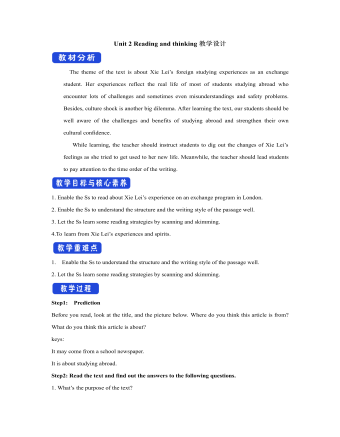
新人教版高中英语选修2Unit 2 Reading and thinking教学设计
Her tutor told her to acknowledge __________ other people had said if she cited their ideas, and advised her _______(read) lots of information in order to form __________wise opinion of her own.Now halfway __________ her exchange year, Xie Lei felt much more at home in the UK. She said __________ (engage) in British culture had helped and that she had been__________ (involve) in social activities. She also said while learning about business, she was acting as a cultural messenger __________(build) a bridge between the two countries. keys:Xie Lei, a 19yearold Chinese student, said goodbye to her family and friends in China and boarded (board) a plane for London six months ago in order to get a business qualification. She was ambitious(ambition) to set up a business after graduation. It was the first time that she had left (leave) home.At first, Xie Lei had to adapt to life in a different country. She chose to live with a host family, who can help with her adaptation (adapt) to the new culture. When she missed home, she felt comforted (comfort) to have a second family. Also Xie Lei had to satisfy academic requirements. Her tutor told her to acknowledge what other people had said if she cited their ideas, and advised her to read lots of information in order to form a wise opinion of her own.Now halfway through her exchange year, Xie Lei felt much more at home in the UK. She said engaging (engage) in British culture had helped and that she had been involved (involve) in social activities. She also said while learning about business, she was acting as a cultural messenger building a bridge between the two countries.
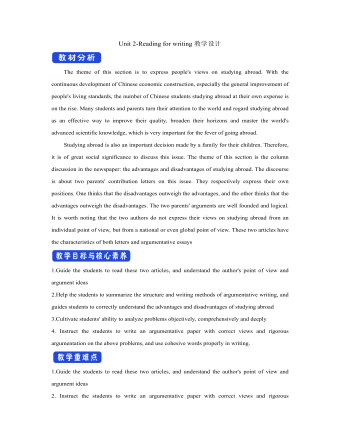
新人教版高中英语选修2Unit 2 Reading for writing教学设计
The theme of this section is to express people's views on studying abroad. With the continuous development of Chinese economic construction, especially the general improvement of people's living standards, the number of Chinese students studying abroad at their own expense is on the rise. Many students and parents turn their attention to the world and regard studying abroad as an effective way to improve their quality, broaden their horizons and master the world's advanced scientific knowledge, which is very important for the fever of going abroad. Studying abroad is also an important decision made by a family for their children. Therefore, it is of great social significance to discuss this issue. The theme of this section is the column discussion in the newspaper: the advantages and disadvantages of studying abroad. The discourse is about two parents' contribution letters on this issue. They respectively express their own positions. One thinks that the disadvantages outweigh the advantages, and the other thinks that the advantages outweigh the disadvantages. The two parents' arguments are well founded and logical. It is worth noting that the two authors do not express their views on studying abroad from an individual point of view, but from a national or even global point of view. These two articles have the characteristics of both letters and argumentative essays1.Guide the students to read these two articles, and understand the author's point of view and argument ideas2.Help the students to summarize the structure and writing methods of argumentative writing, and guides students to correctly understand the advantages and disadvantages of studying abroad3.Cultivate students' ability to analyze problems objectively, comprehensively and deeply
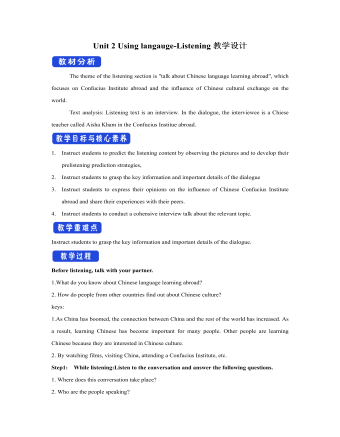
新人教版高中英语选修2Unit 2 Using langauge-Listening教学设计
? B: Absolutely! Getting involved with Chinese cultural activities there definitely helped a lot. I got to practice my Chinese on a daily basis, and I could learn how native Chinese speakers spoke.? A: What do you feel is your biggest achievement?? B: Learning Chinese characters! I have learnt about 1,500 so far. When I first started, I didn't think it was even going to be possible to learn so many, but now I find that I can read signs, menus, and even some easy newspaper articles.? A: What are you most keen on?? B: I've really become keen on learning more about the Chinese culture, in particular Chinese calligraphy. As I have learnt Chinese characters, I have developed a great appreciation for their meaning. I want to explore Chinese characters by learning how to write them in a more beautiful way. ? A: Finally, what do you want to say to anyone interested in learning Chinese?? I have really become keen on learning more about the Chinese culture, in particular Chinese Calligraphy. As I have learnt Chinese character, I have developed a great appreciation for their meaning. I want to explore Chinese characters by learning how to write them in a more beautiful way.? A: Finally, what do you want to say to anyone interested in learning Chinese?? B: I'd say, give it a shot! While some aspects may be difficult, it is quite rewarding and you will be happy that you tried.? A: Thanks for your time. ? B:You're welcome.

新人教版高中英语必修3Unit 2 Morals and Virtues教学设计二
Activity 41. Students complete the task of activity 4, then teachers and students check the answers. 2. The teacher organized the students to work together and asked them to use the tables and mind maps sorted out before to retold the important choices in Lin Qiaozhi's life and their resultsStep 5 Language points1. The teacher asks the students to read the text carefully, find out the core words and long and difficult sentences in the text and draw lines, understand the use of vocabulary, and analyze the structure of long and difficult sentences. 2. The teacher explains and summarizes the usage of core vocabulary and asks the students to take notes. 3. The teacher analyzes and explains the long and difficult sentences that the students don't understand, so that the students can understand them better. Step 6 Homework1. Read the text again, in-depth understanding of the text; 2. Master the use of core vocabulary and understand the long and difficult sentences. 3. Complete relevant exercises in the guide plan. 1、通过本节内容学习,学生是否理解和掌握阅读文本中的新词汇的意义与用法;2、通过本节内容学习,学生能否结合文本特点总结林巧稚的人生原则和人格品质特征;3、通过本节内容学习,学生能否针对人生抉择发表自己的看法;能否全面地、客观地、理性地看待问题,进而对道德和人性有更加深入的思考和理解。

新人教版高中英语必修3Unit 2 Morals and Virtues教学设计三
The joke set her crying.这个玩笑使她哭起来。Step 5 ReadingActivity 31. Students read the small text in activity 3. The teacher provides several small questions to check whether students understand the content of the text and the ideographic function of the -ing form in the text.*Where are those people?*Why did Dr Bethune come to China?*How did he help the Chinese people during the war?*What did Chairman Mao Zedong say about him?2. Ss try to rewrite some sentences using the -ing form. Then check the answers. When checking the answers, the teacher can ask different students to read the rewritten sentences and give comments.Answers:1. he became very interested in medicine, deciding to become a doctor.2. …after hearing that many people were dying in the war.3. Helping to organise hospitals, he taught doctors and nurses, and showed people how to give first aid./ He helped to organise hospitals, teaching doctors and nurses, and showing people how to give first aid.4. …praising Dr Bethune as a hero to be remembered in China.Step 6 PracticeActivity 4Students complete grammar activities 2 and 3 on page 69 of the workbook.Step 6 Homework1. Understand and master the functions and usage of the -ing form;2. Finish the other exercises in Using structures.1、通过本节内容学习,学生是否理解和掌握动词-ing形式作宾语补足语语和状语语的功能和意义;2、通过本节内容学习,学生能否正确使用动词-ing形式描述人物的行为、动作及其经历;3、通过本节内容学习,学生能否独立完成练习册和导学案中的相关练习。